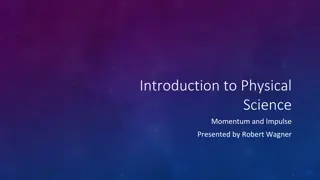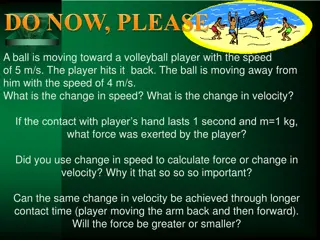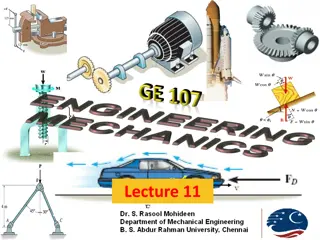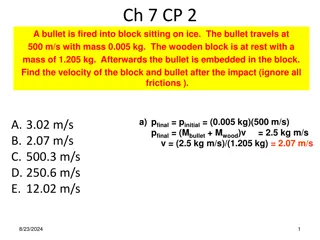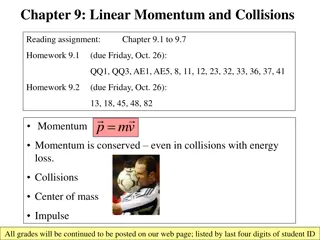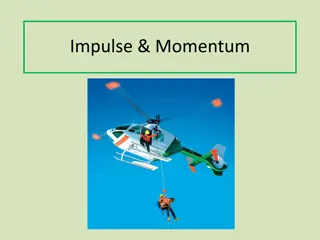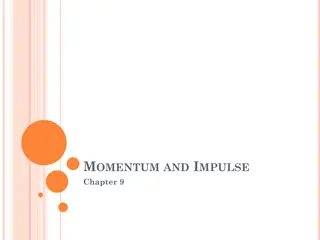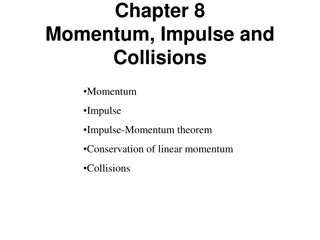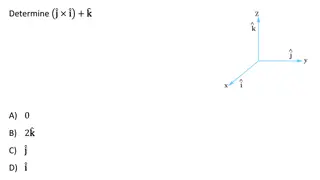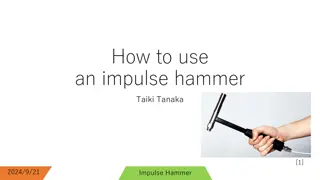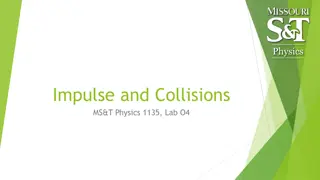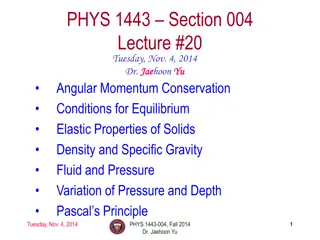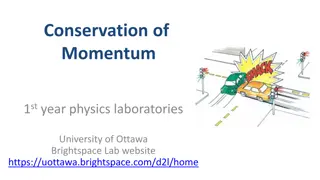Understanding Momentum and Impulse in Physics
Explore the concepts of momentum and impulse in physics, illustrated through practical examples like a race car crash and a hockey puck's motion. Learn how Newton's laws of motion govern these principles and how they relate to force and velocity. Dive into the interplay between momentum and impulse, crucial in understanding the behavior of objects in motion and collisions.
Download Presentation

Please find below an Image/Link to download the presentation.
The content on the website is provided AS IS for your information and personal use only. It may not be sold, licensed, or shared on other websites without obtaining consent from the author. Download presentation by click this link. If you encounter any issues during the download, it is possible that the publisher has removed the file from their server.
E N D
Presentation Transcript
Momentum & Impulse Pg. 222- 227
Momentum & Impulse The driver of this race car walked away from the car without a scratch Luck had little to do with this fortunate outcome though a practical application of Newton s laws of motion by the engineers who designed the car and its safety equipment protected the driver from injury
Momentum When Newton originally formulated his laws of motion, he expressed them in a somewhat different form than you can see in most textbooks today. Newton emphasized a concept called a quantity of motion , which is defined as the product of an object s mass and its velocity. Today, we call this quantity momentum
Momentum Since momentum is the product of a vector and a scalar, momentum is a vector quantity The direction of the momentum is the same as the direction of the velocity
note Momentum (p)
Practice 1. Determine the momentum of a 0.30 kg hockey puck travelling across the ice at a velocity of 5.6 m/s [N]. (1.7 kg-m/s)
Impulse Newton s first law states that the velocity of an object is constant unless acted on by an external force So, if a net force is applied to an object, its velocity will change and, therefore, its momentum will also change Expressed mathematically, his second law, F=ma, can be rewritten as:
note Impulse ( p)
2. If a golf club exerts an average force of 5300 N[W] on a golf ball over a time interval of 0.00054 s, what is the impulse of the interaction?
Impulse-Momentum Thery In many collisions, It is exceedingly difficult to make the precise impulse This is because the force changes continually throughout few milliseconds of contact between the two object
Impulse-Momentum Theory For example, when a golf club first contacts a golf ball, the force is very small Within milliseconds, the force is great enough to deform the ball The ball then begins to move and return to its original shape and the force soon drops back to zero
Impulse-Momentum Theory You could find the impulse by determining the area under the curve of force versus time (which can be tedious) An alternative and much easier approach is to analyze the momentum before and after the interaction between two objects
note Impulse-Momentum Theorem
Practice 3. A 0.16 kg puck is traveling at 5.0 m/s[N] when a slapshot changes the puck s velocity to 40 m/s[S] If the collision lasted 0.0020 s, A) calculate the impulse imparted by the hockey stick B) determine the average force applied by the stick to the puck 4. A student practices her tennis volleys by hitting a ball against a wall A) if the 0.060 kg ball travels at 50 m/s[W] before hitting the wall and then bounces directly backward at 35 m/s[E], what is the impulse of the interaction? B) if the duration of the interaction is 25 ms, what is the average force exerted on the ball by the wall?
Impulse & Auto Safety Once of the most practical and important applications of impulse is in the design of automobiles and their safety equipment When a car hits another car or a solid wall, little can be done to reduce the change in momentum The mass of the car certainly does not change, while the velocity changes to zero at the moment of impact Since you cannot reduce the change in momentum, you cannot reduce the impulse However, since impulse (F t) depends on both force and time, engineers have found ways to reduce the force exerted on car occupants by extending the time interval of the crash
Impulse & Auto Safety In the early days, engineers and designers thought that a very strong, solid car would be ideal As the number of cars on the road and the speed of the cars increased, the number and seriousness of accident injuries made it clear that the very sturdy cars were not protecting the car occupants By the late 1950s and the early 1960s, engineers were designing cars with very rigid passenger cells that would not collapse on the passengers, but with less rigid crumple zones in the front and rear, as shown
Impulse & Auto Safety When a rigid car hits a wall, a huge force stops the car almost instantaneously The car might even look as though it was only slightly damaged However, parts of the car, such as the steering wheel, windshield, or dashboard, exert an equally large force on the passengers, stopping them exceedingly rapidly and possibly causing very serious injuries
Impulse & Auto Safety When a car with well-designed crumple zones hits a wall, the force of the wall on the car causes the front of the car to collapse over a slightly longer time interval than it would in the absence of a crumple zone Since F tis constant and t is larger, the average force, F, is smaller than it would be for a rigid car Although many other factors must be considered to reduce injury in collisions, the presence of crumple zones has had a significant effect in reducing the severity of injuries in automobile accidents
Impulse & Safety Equipment The concept of increasing the duration of an impact applies to many forms of safety equipment For example, the linings of safety helmets are designed to compress relatively slowly If the lining was extremely soft, it would compress so rapidly that the hard outer layer of the helmet would impact on the head very quickly If the lining did not compress at all, it would collide with the head over an extremely short time interval and cause serious injury Each type of sport helmet is designed to compress in a way that compensates for the type of impacts expected in that sport
note Impulse & Safety Since p = F tand p does not change when time is increased in order to decrease force Important application is in the design of safety equipment Crumple zones Air bags Safety helmets Sports equipment (although a car crash seems almost instantaneous, the time taken for the front or rear of the car to crumple is great enough to significantly reduce the average force of the impact and, therefore, the average force exerted on the passenger cell and the passengers)
Practice 5. A bungee jumper jumps from a very high tower with bungee cords attached to his ankles. As he reaches the end of the bungee cord, it begins to stretch. The cord stretches for a relatively long period of time and then it recoils, pulling him back up. After several bounces, he dangles unhurt from the bungee cord. Use the concept of impulse to explain the different in the results of a jump using a proper bungee cord and a jump using an ordinary rope.
Textbook Pg. 227 #3,5, 9 -11 Pg. 257 #1-4 (PJ: Momentum & The Neutrino)


